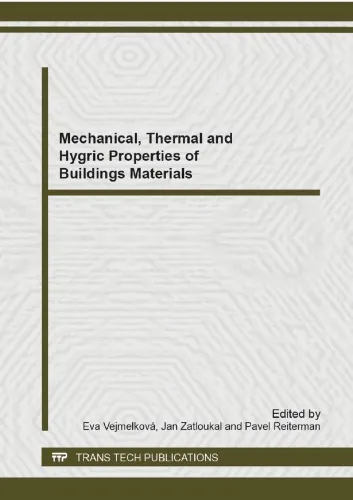Mechanical, Thermal and Hygric Properties of Buildings Materials
4.8
Reviews from our users

You Can Ask your questions from this book's AI after Login
Each download or ask from book AI costs 2 points. To earn more free points, please visit the Points Guide Page and complete some valuable actions.Introduction
Welcome to "Mechanical, Thermal and Hygric Properties of Building Materials" – a comprehensive guide that delves into the critical properties of building materials that define their performance and sustainability. In an era where building efficiency and environmental impact are paramount, understanding these properties is essential for architects, engineers, and builders alike. This book provides an in-depth analysis of these key material characteristics, helping professionals make informed decisions to enhance the functionality and efficacy of their projects.
Detailed Summary of the Book
The book is structured to systematically explore the fundamental mechanical, thermal, and hygric properties of commonly used building materials. The initial chapters provide a foundational understanding of mechanical properties, explaining stress-strain relationships, tensile strength, compressive strength, and elasticity. The importance of these properties in ensuring structural integrity and safety is elaborated using various case studies and practical examples.
Following this, the book transitions to thermal properties, highlighting the role of materials in heat transfer, insulation, and energy efficiency. Topics such as thermal conductivity, specific heat capacity, and thermal diffusivity are explored in detail, offering insights into how these factors influence the indoor climate and energy consumption of buildings.
In its final section, the book addresses hygric properties, a crucial aspect often overlooked. It examines moisture transport mechanisms, sorption isotherms, and vapor permeability. Understanding these properties is essential for preventing issues like mold growth and structural deterioration, promoting healthier and longer-lasting buildings.
Key Takeaways
- How mechanical properties impact the structural stability and longevity of buildings.
- The significance of thermal properties in achieving energy efficiency and occupant comfort.
- The role of hygric properties in moisture control and maintaining building health.
- Real-world applications and case studies showcasing material performance under various conditions.
- Guidelines for selecting the appropriate materials based on project requirements and environmental considerations.
Famous Quotes from the Book
"The science of building materials is as ancient as architecture itself, yet as modern as the latest technological advances."
"Material selection is not merely an engineering decision but a critical assessment of performance, durability, and sustainability."
Why This Book Matters
In a world increasingly focused on sustainability and efficiency, "Mechanical, Thermal and Hygric Properties of Building Materials" serves as an indispensable resource for anyone involved in the construction and design industry. With an extensive exploration of critical material properties, this book guides professionals in making choices that lead to not only structurally sound and efficient buildings but also environmentally responsible ones. By bridging the gap between theory and application, it empowers its readers to innovate and improve upon traditional practices, striving towards a future of sustainable development.
Whether you are a seasoned professional or a student entering the field, this book will enhance your understanding of the essential properties of building materials, giving you the tools to design and build more effectively. Its balanced approach to both theoretical concepts and practical applications ensures that readers can apply this knowledge directly to their projects, making it a must-have addition to any construction professional’s library.
Free Direct Download
You Can Download this book after Login
Accessing books through legal platforms and public libraries not only supports the rights of authors and publishers but also contributes to the sustainability of reading culture. Before downloading, please take a moment to consider these options.
Find this book on other platforms:
WorldCat helps you find books in libraries worldwide.
See ratings, reviews, and discussions on Goodreads.
Find and buy rare or used books on AbeBooks.
1246
بازدید4.8
امتیاز50
نظر98%
رضایتReviews:
4.8
Based on 0 users review
"کیفیت چاپ عالی بود، خیلی راضیام"
Questions & Answers
Ask questions about this book or help others by answering
No questions yet. Be the first to ask!


